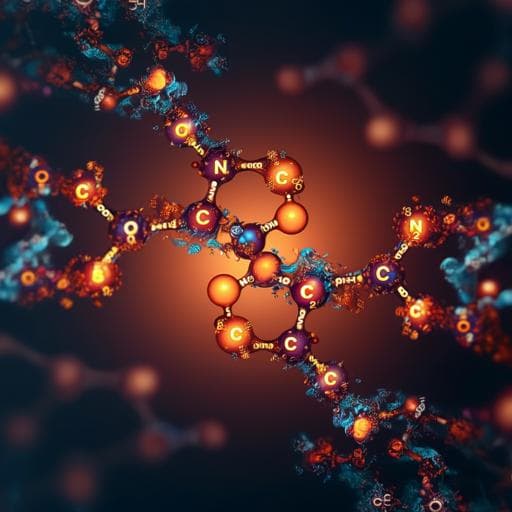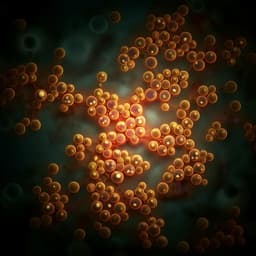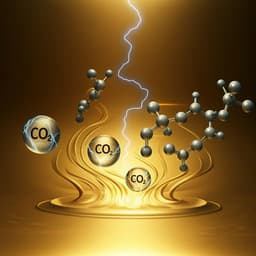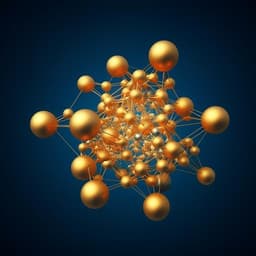
Chemistry
Unraveling the rate-determining step of C<sub>2+</sub> products during electrochemical CO reduction
W. Deng, P. Zhang, et al.
Discover how researchers Wanyu Deng, Peng Zhang, Yu Qiao, and others uncovered the critical rate-determining step in the electrochemical reduction of CO to valuable multi-carbon products. Their findings highlight the dominance of *CO-*CO coupling, offering exciting insights into sustainable fuel production.
~3 min • Beginner • English
Introduction
Electrochemical CO reduction (COER) on copper is a promising route to store renewable electricity in chemical bonds by producing multi‑carbon (C2+) products. Despite significant advances, commercial viability is hindered by incomplete mechanistic understanding, particularly the identity of the rate‑determining step (RDS) for C2+ formation. Competing hypotheses include C–C coupling between adsorbed and/or dissolved CO and protonation (hydrogenation) of adsorbed CO. Establishing the RDS is crucial for rational catalyst and process design to improve selectivity, activity, and overall electrolyzer efficiency. This work aims to resolve whether C–C coupling or CO hydrogenation is the RDS by integrating kinetic theory with experiments that independently vary proton availability, isotope composition, and CO coverage (via partial pressure).
Literature Review
Prior DFT and experimental studies proposed several potential RDSs for C2+ formation on Cu: (i) *CO–CO(g) coupling, (ii) *CO–*CO coupling, and (iii) *CO protonation to *CO(H) via different proton sources (H2O, H+, or surface *H). Kinetic observations (e.g., Tafel slopes, CO reaction orders, and pH dependence) have yielded conflicting interpretations: zero CO reaction order at high PCO and pH‑independent activity support *CO–*CO coupling, whereas negative or −1 CO reaction order at low PCO has been interpreted as consistent with protonation steps. Reports of pH independence even in acidic media challenge proton‑involving RDS assignments. Discrepancies have been attributed to incomplete kinetic analyses and mass‑transfer complications. The present study derives explicit rate expressions for each hypothesized mechanism to enable unambiguous comparison to experiments across CO partial pressures and electrolytes.
Methodology
Approach: Combine mechanistic rate derivations with controlled kinetic experiments to identify the RDS for C2+ formation.
- Theoretical derivation: For each hypothesized mechanism (Tables 1–2), derive current–potential–pressure relations and reaction orders. For *CO–*CO coupling (step A2), the derived form is j_C2+ = k_A2 (K_CO^2 H_CO^2 P_CO^2)/(1 + K_CO H_CO P_CO)^2 exp(−αη), yielding η_CO = 2/(K_CO H_CO P_CO + 1), and η_H = η_H2O = 0.
- Catalysts: Polycrystalline Cu thin films (100 nm) sputtered on Ti/Si(100). Commercial Cu nanoparticles (40–60 nm) and oxide‑derived Cu (OD‑Cu) were also tested to assess generality.
- Characterization: XRD (Cu Kα), XPS (Al Kα), SEM.
- Electrochemical setup: Custom three‑electrode PEEK cell, IrO2 counter, Hg/HgO reference calibrated to SHE, BPM separator; catholyte 7 mL, anolyte 0.9 mL; electrolyte flow via peristaltic pump to minimize diffusion limitations (boundary layer ~12 μm). Gas purification with carbonyl trap. GC (TCD/FID) for gaseous products (H2, CH4, C2H4, C2H6); HPLC (RID) for liquid products (e.g., glycolaldehyde, acetate, ethylene glycol, ethanol, propionaldehyde, n‑propanol). IR compensation applied.
- Electrolytes and pH variation: 0.1 M KOH (pH 13), 0.1 M KHCO3 (pH 9), 0.1 M KH2PO4 (pH 3), and 0.05 M K2SO4 adjusted with H2SO4 (pH 2). K+ concentration maintained at 0.1 M to control cation effects. Local pH assessed via mass‑transfer modeling; trends mirror bulk pH.
- Kinetic isotope effect (KIE): H2O vs D2O electrolytes (0.1 M KHCO3 vs 0.1 M KDCO3; also KOH and KH2PO4 analogues in D2O) to probe proton/H2O involvement at or before the RDS.
- CO partial pressure: P_CO varied 0.02–1 bar by mixing CO/Ar; tests primarily at −1.3 V vs SHE in 0.1 M KOH. CO conversion ~0.02% ensured non‑depleting CO supply. Data fitted with the mechanistically derived rate expressions (non‑linear fits) to extract reaction orders and discriminate mechanisms.
- Operating controls: Potentials chosen to avoid CO mass‑transport limitations (verified by sustained Tafel‑like regions over 3 orders of magnitude; stable currents over 1 h). Replicates n=3 for statistics.
- Additional catalysts: Same pH/KIE/P_CO protocols applied to commercial Cu NP and OD‑Cu.
Key Findings
- pH dependence: C2+ and C2H4 partial currents are nearly invariant from acidic (pH 2–3) to alkaline (pH 13) at fixed potentials, indicating no positive order in proton activity for the RDS (η_H ≈ 0). CH4 and H2 increase at lower pH, consistent with proton‑involving RDS for those products.
- KIE: Switching H2O to D2O (KHCO3 to KDCO3 and analogous acidic/alkaline electrolytes) yields C2+ and C2H4 currents unchanged (KIE ≈ 1), indicating H2O/protons do not participate in or precede the RDS for C2+ formation. In contrast, CH4 and H2 currents decrease in D2O, consistent with proton‑involving steps for those products.
- CO partial pressure: j_C2+ increases with P_CO up to ~0.5 bar and plateaus thereafter; reaction order n_CO ≈ 1 at low P_CO (<~0.15 bar) and ≈ 0 at high P_CO (>~0.5 bar). Non‑linear fitting to mechanistic rate expressions shows only the *CO–*CO coupling (step A2) reproduces the entire j vs P_CO curve and residuals; alternatives (*CO–CO(aq) coupling or *CO protonation via H2O/H+/*H) do not fit.
- Derived kinetics: For step A2, η_CO = 2/(K_CO H_CO P_CO + 1), predicting the observed transition from second‑ to zero‑order behavior in the numerator/denominator form; experiments align with η_H = η_H2O = 0.
- Generality: Commercial Cu nanoparticles and OD‑Cu exhibit the same qualitative behavior: pH independence for C2+, KIE ≈ 1, and P_CO dependence only fit by *CO–*CO coupling, indicating a shared RDS across these Cu catalysts.
- Operating specifics: Experiments at −1.3 V vs SHE (typical), boundary layer ~12 μm; CO conversion ~0.02% ensures kinetic regime; total Faradaic efficiency near 100% (±10%). Data largely reflect C2H4 due to low ethanol/acetate/n‑propanol currents.
Discussion
The combined kinetic probes conclusively indicate that the RDS for C2+ formation in COER on polycrystalline Cu is the coupling of two adsorbed CO species (*CO–*CO). The lack of pH dependence and unit KIE exclude mechanisms where proton transfer or water activation is involved at or prior to the RDS. The observed CO pressure dependence—with rising activity at low P_CO and saturation at higher P_CO—is quantitatively captured only by the rate expression derived for *CO–*CO dimerization, not by *CO–CO(aq) coupling or *CO protonation mechanisms. This mechanistic assignment is robust across catalyst morphologies (polycrystalline films, commercial nanoparticles, OD‑Cu), suggesting that on Cu the C–C coupling between adsorbed CO is the bottleneck for C2+ formation under the tested conditions. These findings prioritize strategies that increase surface *CO coverage and facilitate *CO–*CO interaction/transition state stabilization to enhance C2+ rates and selectivity.
Conclusion
By unifying mechanistic rate derivations with targeted kinetic experiments (pH dependence, H/D KIE, CO partial pressure), this study identifies *CO–*CO dimerization as the rate‑determining step for C2+ product formation during electrochemical CO reduction on copper. The approach yields consistent reaction orders (η_H ≈ 0, η_H2O ≈ 0; η_CO transitioning from ~1 at low P_CO to ~0 at high P_CO) and reproduces the entire j vs P_CO trend only for the *CO–*CO mechanism. The RDS assignment extends to commercial Cu nanoparticles and oxide‑derived Cu, suggesting broad applicability. Future work should target catalysts and electrolytes that stabilize *CO and the OCCO* intermediate, and expand the kinetic framework to product‑specific pathways (e.g., ethanol, acetate, C3+), where distinct RDSs may emerge.
Limitations
- Product specificity: Due to low rates of ethanol, acetate, and n‑propanol under tested conditions, conclusions predominantly reflect C2H4 formation; different C2+/C3+ products may have distinct RDSs.
- Electrolyte anions: While K+ concentration was controlled, anion identity (e.g., phosphate adsorption/proton donation) may influence surface chemistry, particularly in acidic media; sulfate was used to mitigate but anion effects cannot be entirely excluded.
- Mass transport and local environment: Although boundary layer thinning and modeling suggest minimal mass‑transport artifacts and consistent local pH trends, residual effects cannot be fully ruled out.
- Tafel analysis: Not employed due to sensitivity to mass transport and unknown transfer coefficients; conclusions rely on reaction orders and non‑linear fitting to derived rate expressions.
- Parameter extraction: Fitting relies on assumed forms (e.g., dominant *CO coverage) and constants (Henry’s constant, adsorption equilibrium), which introduce uncertainty.
Related Publications
Explore these studies to deepen your understanding of the subject.







